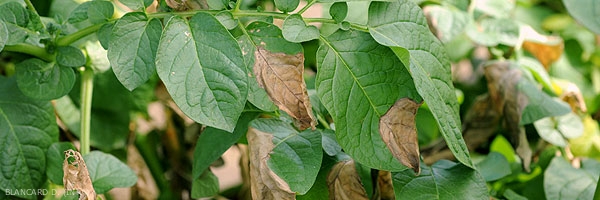
Phytophthora infestans
Late blight
- Causal agent and transmission
Potato late blight is caused by Phytophthora infestans which is not a fungus but a water mould also known as “oomycete”. It produces mycelium which can be of two different type of strains: A1 and A2, that are of opposite sexual compatibility. The mating of the two sexually compatible strains, on a potato plant, may lead to the formation of oospores (photo 1). The latter are resistant organs which can survive in the soil for several years. Until now, this has been a rare event in Europe.
More frequently, the cycle of Phytophtora infestans is asexual. In winter, it normally survives in the form of asexual mycelium in tubers left in the field (ground keepers), in waste piles and in storage. In the spring, this surviving mycelium produces sporangia which are spread by wind and rain, infecting new healthy plants and crops. Under conditions of high humidity, one cycle normally takes 4 to 6 days at an average temperature of 15°C. After the primary infection, subsequent infection cycles can occur and be responsible for a very rapid and destructive epidemic on the foliage.
Later in the growing cycle of the potato, newly formed tubers are directly infected in the field: sporangia formed on the aerial parts of the plants are carried by rainwater into the soil and infect the tubers.
Potato and tomato plants are the unique hosts of this pathogen.
- Significance
Occurring worldwide, potato late blight remains the most difficult disease to control in potato production. Late blight is a threat wherever potatoes are grown andit can be particularly serious in crops grown in temperate, cool and humid climates. Under high disease pressure, optimal late blight control requires repeated and preventive, expensive chemical treatments. If left uncontrolled, the economic result can be a complete yield loss.
Under organic potato production, the control of this disease is one of the most challenging procedures due to the lack of authorised fungicides (only copper-based products).





